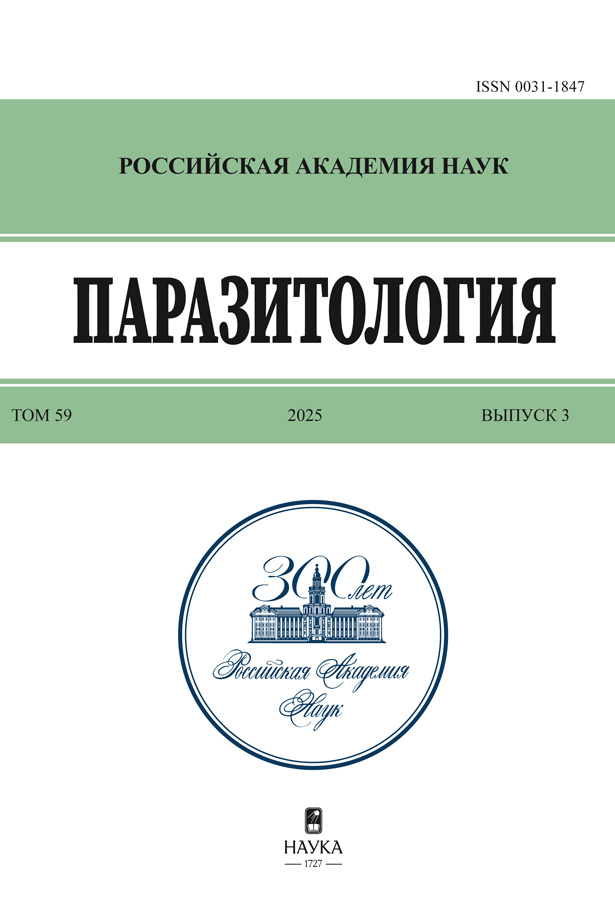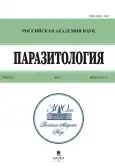Parazitologiâ
ISSN (print): 0031-1847
Media registration certificate: No. FS 77 - 66711 dated July 28, 2016
Founder: Russian Academy of Sciences
Editor-in-Chief: Pugachev Oleg Nikolaevich
Number of issues per year: 6
Indexation: RISC, CrossRef, White List (level 3), Web of science
The journal "Parazitologiya" was founded in 1967.
"Parazitologiya" is the first and leading peer-reviewed scientific journal on parasitology published in Russia.
The aim of the journal is to facilitate parasitology research in Russia and worldwide by providing an efficient, high-quality and modern platform for scientific communication.
The scope of the journal embraces a wide range of parasitological topics, except for highly specialized aspects of medicine and veterinary science.
- Biodiversity, distribution and systematics. Descriptions of new species are welcome if they also contribute to some general conclusions.
- Wide range of research objects: any parasitic metazoans, fungi and protists, as well as bacteria and viruses — if the study has general parasitological relevance.
- Studies on morphology that broaden understanding of form and function in parasitic organisms.
- Ecological parasitology, life cycles and transmission pathways of parasites; phylogeography.
- Host-parasite interactions at different levels.
- Evolution, co-evolution and phylogeny.
- General and fundamental questions of parasitology.
- Vector-borne diseases with natural reservoirs (if the accent is on parasitology rather than medicine or veterinary science).
The journal is published 6 times a year in Russian and English languages. The name of the English version is Entomological Review.
The journal is presented in many databases, including the Web of Science and RSCI.
Current Issue
Vol 59, No 3 (2025)
Articles
Flea species (Siphonaptera) as vectors of plague in natural foci of the World (Part 1)
Abstract
The review provides information on the types of habitats and distribution, parasite-host relationships of 94 species of fleas known as plague vectors in natural foci in various regions of the world. In particular, the following are considered: 1) 37 species of the families Pulicidae, Tungidae, Rhopalopsyllidae, Vermipsyllidae and Coptopsyllida, 2) 53 species of the families Hystrichopsyllidae s. l., Chimaeropsyllidae and Stephanocircidae, 3) four species of the family Stivaliidae.
 179–214
179–214


Male longevity in Aedes (Ochlerotatus) communis (de Geer) and A. (O.) cantans (Meigen) (Diptera, Culicidae) reared from embryos in laboratory conditions
Abstract
Adult longevity in male mosquitoes Aedes (Ochlerotatus) communis (de Geer) and A. (O.) cantans (Meigen), reared from embryos in laboratory, was estimated. These two species were also compared with each other by the duration of development from egg hatching to adult emergence. Eggs (developed embryos, already passed through the diapause) were collected with fallen leaves and pieces of soil from under the snow at the edge of the pond, where large quantities of larvae of these species were spotted in the previous spring. A loose mass of fallen leaves and ground (1 L), containing mosquito eggs, was placed in a 10-L enamel container with cold (4°C) tap water. Water temperature gradually increased up to 21–22°С during several hours. After 2 days of incubation, water with hatched larvae was transferred to a new 10-L enamel container, while the most part of leaves and soil was removed. In this water, at 21–22°С and natural light regimen (during February–March at 59°51’N), larvae developed to pupae. Emerged adults were reared in groups in specially constructed transparent plastic containers with free access to sucrose and water, with mean environmental temperature 22.4°С, 50% air humidity inside containers, and natural light regimen. It was revealed that A. communis develops faster and emerges earlier than A. cantans: emergence of male A. communis and A. cantans started after 11.5 and 13 days, respectively, from the placement of the embryos in water, and lasted no more than 2.5 and 3 days, respectively. Adult longevity in males of A. communis was, in general, shorter than that in males of A. cantans: median values were 7.5 and 20 days for male A. communis and A. cantans, respectively. The results demonstrate that A. cantans males are more convenient for prolonged experiments under laboratory conditions than males of A. communis. Comparisons of present results with the previous data suggest that adults of A. cantans reared from embryos in a laboratory are, in general, not less viable than their conspecifics hatched and developed in pre-imaginal stages in natural conditions, and that there are differences in longevity in adult male A. cantans reared from different samples of embryos.
 215–223
215–223


Colubrid snakes as paratenic capture hosts of the nematode Spiroxys contortus (Chromadorea, Gnathostomatidae) in the Low Volga region
Abstract
The material for this work was based on our collection of the larvae of Spiroxys contortus (Rudolphi, 1819) from colubrid snakes in the Lower Volga region in 2020. A total of 28 specimens of S. contortus larvae were collected from the grass snake Natrix natrix (Linnaeus, 1758) and dice snake N. tessellata (Laurenti, 1768). In Russia the parasite was recorded in the grass snake N. natrix for the first time. The morphological and morphometric features of S. contortus larvae from the grass and dice snakes were presented.
 224–230
224–230


Long non-coding RNAs of the trematode Himasthla Elongata (Mehlis, 1831) (Trematoda, Himasthlidae)
Abstract
The molecular mechanisms regulating the life cycle of trematodes remain largely unexplored to date. It is hypothesized that the non-coding portion of the genome, particularly long non-coding RNAs (lncRNAs) and repetitive elements, plays a key role in this regulation. In this study, we present the first identification of lncRNAs in the trematode Himasthla elongata based on transcriptome analysis combined with repeat homology assessment. Approximately half of the identified lncRNAs contain transposon-derived regions, reflecting the fact that transposable elements occupy 57.5% of the genome. The expression of several lncRNAs was confirmed across the redia, cercaria, and metacercaria life stages. These findings provide a basis for further study of the role of mobile elements in the formation of regulatory RNAs and in the evolution of transcription regulation mechanisms in trematodes.
 231-251
231-251


Long-term dynamics of the helminthofauna of the kittiwakes (Rissa tridactyla L., 1758) in the Seven Islands archipelago (Barents Sea)
Abstract
The long-term dynamics of helminth fauna of adult kittiwakes (Rissa tridactyla L., 1758) in nesting colonies on Kharlov Island (Seven Islands Archipelago, Barents Sea, Kandalaksha State Nature Reserve) was investigated. A tendency of steady decrease in the species diversity of bird parasites was revealed. The values of quantitative parameters of invasion with key species of the helminth fauna (cestodes Alcataenia larina and Tetrabothrius erostris, and nematodes Paracuaria adunca) for three stages of studies (in 1940-41, 1991 and 2024) almost did not undergo statistically significant changes. The results obtained are probably explained by the fact that climatic fluctuations and anthropogenic pressure may have caused a certain reorganization of parasite-host relationships, but did not disturb the structure and stability of the main parasitic systems. Based on the results of the analysis of stomach contents, the peculiarities of bird nutrition in different periods were studied. The features and likely causes of the geographical distribution and specificity of helminths were analyzed, a comprehensive assessment of kittiwakes infestation on the Murman coast was conducted.
 252-264
252-264










